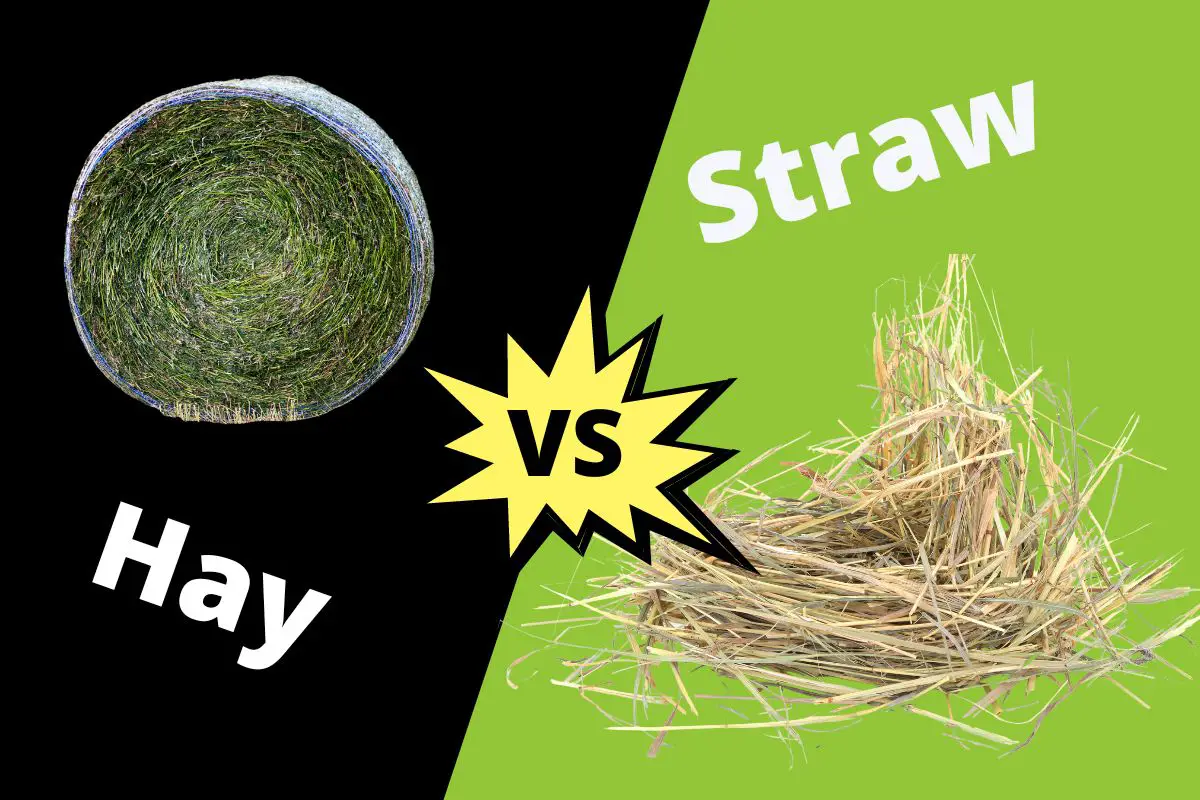The main difference between hay and straw is that hay is fed to animals because it’s green, leafy, and aromatic. However, straw is mainly used for bedding since it’s wheat, stems of oats, or another crop.
Both plants look almost the same, but there are some significant differences between the two. Read this article to understand the difference in picking the correct type of forage for your animal.
Table of Contents
Hay vs. Straw
| Hay | vs | Straw |
| Hay includes grass or alfalfa and leaves | Composition | Straw contains the byproduct stems of grains such as wheat and rice |
| Used as fodder for livestock | Primary Use | Used as bedding material for animals |
| The shade of light green with the slightly sweet smell | Appearance | Golden color without smell |
| Heavier | Weight | Lighter |
| More expensive | Cost | Less expensive |
| High | Moisture Content | Low |
What is Hay?
Hay is a mixture of grasses such as ryegrass, orchard grass, fescue, etc., depending on the area in which it is grown.
Hay also consists of legumes such as clovers and alfalfa.
These grasses are cut, dried, and stored to use as hay, which is animal fodder. Hay provides high-quality fiber and other nutrients to animals. It gets harvested before the plants start producing seeds to retain its nutritional value.
Hay is often used when no grazing land is available for animals to graze or when the weather is unfavorable for pasture availability.
Haymaking
Hay production is called haymaking or doing hay, which involves multiple steps.
Haymaking Steps
- Cutting
- Drying
- Raking
- Processing
- Storing
Hay grows best in temperate climates, such as spring or early summer. Timothy hay is the most nutritious and high-quality hay.
Types of Hay
Hay is categorized into different varieties depending on what plants make it up. Four types of hay include:
- Legumes hay: Legumes hay has high protein and mineral content like calcium and phosphorus. For example, red clover.
- Grass hay: It has more sugar and fiber content. It often grows in the winter season—for example, bermudagrass and fescue.
- Cereal grain hay: Cereal grain hay has plenty of nitrates—for example, oat straw.
What Is Straw?
Straw is the leftover plant material after the harvest of grains like wheat. These hollow stems contain low-quality nutrition and are not very healthy for animals.
Straw is discarded stem material and is used as forage only when there is nothing to feed the animals. It is thus used as stuffing material to create bedding for animals.
In some places, straw is used as garden mulch to prevent soil erosion, thatching, basket making, building material, and decoration. Straw is also employed as a source of bioenergy.
Straw is collected and stored in a straw bale which can be square, round, or rectangular, depending on the type of baler.
Note: Palliasse is a term given to straw-filled mattresses.
Types of Straw
Straw is classified into three types: rice straw, wheat straw, and flax straw.
- Rice straw is intense and has high silica content, making it difficult to burn.
- Flax straw: Flax straw is rot-resistant.
- Wheat straw: Wheat straw is the most common straw for making warm and comfortable bedding. It is easy to handle but also releases dust.
Note: Several other types of straw are usually named after the grain.
Hay vs. Straw – Key Differences
At first glance, hay and straw might seem the same but have some significant differences. Here are the main differences mentioned between the two.
Composition
In terms of composition, hay includes grass or alfalfa and leaves, whereas straw contains the byproduct stems of grains such as wheat and rice.
Primary Use
Hay is used as forage for livestock because of its high nutritional content. In contrast, straw is used as a bedding material for animals.
Appearance
Hay appears as a shade of light green and has a slightly sweet smell. In contrast, straw appears golden in color and has no scent.
Weight
Hay bales are heavier than straw bales.
Cost
The price of hay and straw depends on your area, year, and supply. However, hay is usually more expensive than straw, as the latter is a byproduct.
Moisture Content
The moisture content is usually high in hay compared to straw.
Knowing the Difference Between Hay and Straw
Hay is primarily a forage used for animals, and straw is the waste product left after harvesting grains used as bedding. Hay is intentionally grown, whereas straw results from the discarded stem of various plants, such as wheat, flax, etc.
Now you can easily distinguish between the two and pick the right one for your livestock.



